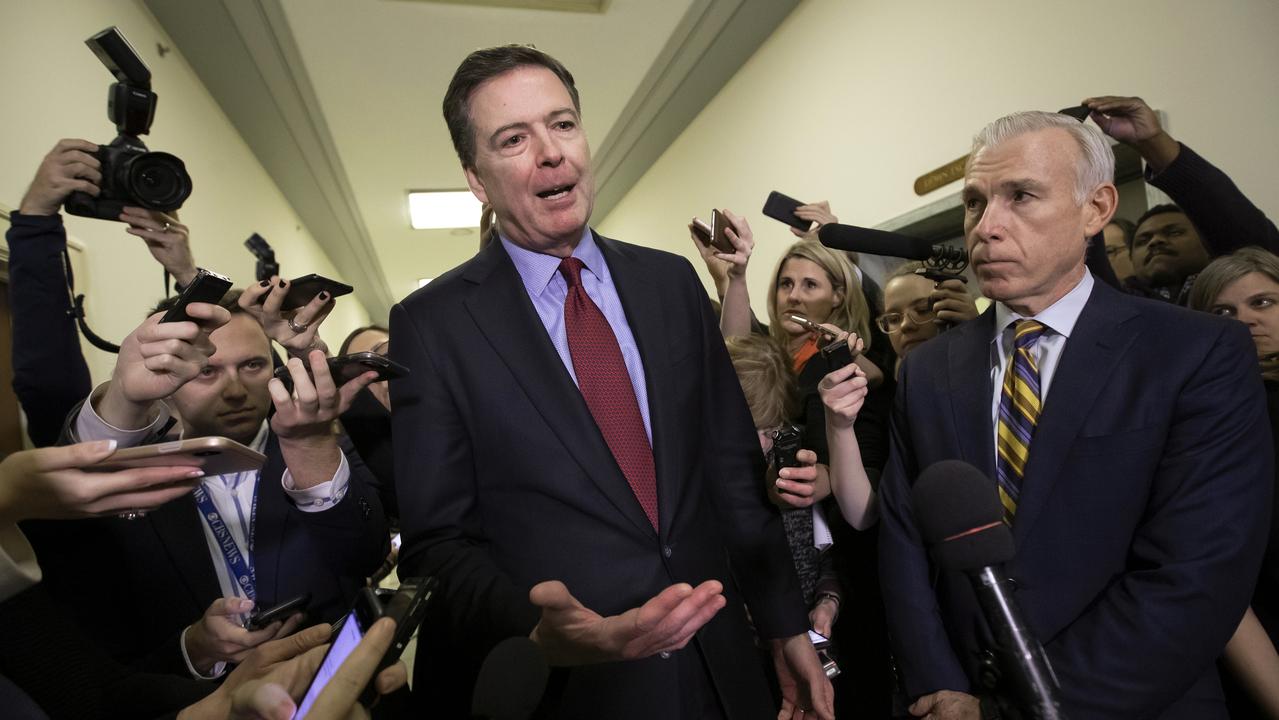Taking a legal leap of faith
Modern Australia finds religion so much on the nose that one of the foundations of Australian democracy is no longer a given.

It is difficult to believe, but modern Australia has developed a bit of a problem with freedom of religion. It is not a raging problem like bushfires, locusts or Dave Warner.
But, just now, Australia is not quite sure how it feels about religious freedom. For some, this ambivalence is deeply worrying. For others, it is an opportunity for major cultural change.
The really surprising thing is that freedom of religion hitherto has been one of the undisputed foundations of Australian democracy. Question it, and more likely you would have been referred for psychiatric assessment than legal processing.
But in 2019 religion is distinctly on the nose, for some fairly profound reasons, and all this needs to be faced honestly. As a result, we have had the review of religious freedom by former parliamentarian Philip Ruddock, and now we are being promised a religious discrimination act by the Morrison government.
So what in the name of Billy Graham is going on?
Well, the good news is no one is being publicly burned. Commissars are not arresting clergy and religious children are not being questioned concerning their parents’ whereabouts.
On the downside, Catholic priests are being spat on in the streets; some no longer wear their clerical collars to avoid the risk. Daily demands are made for the withdrawal of public funds from religious schools. The charitable status of religious bodies is routinely questioned.
In every possible format, the “progressive media” — the new brand name for the ABC and the former Fairfax Media, now part of Nine — conducts a campaign against organised Christianity that is as relentless and humourless as any 1890s temperance movement.
All this has produced the feeling on the part of religious people, noted in the Ruddock report, of low-level nervousness. They are not yet seriously worried about being fed to the lions but do view Taronga Zoo more warily. In such times, should religion be afforded some extra, special protection?
Problematically for everyone, the entire debate over religious freedom is taking place against the roiling background of child sexual abuse. This has discredited and to a significant extent morally paralysed the churches. It has encouraged every hater of religion to believe anew that the last problem of the world will be solved when the last priest is hanged from the last lamppost.
Unsurprisingly, therefore, the debate around freedom of religion — its scope and future protection — has been one of the most confused and deceptive in our country’s recent political history. Different parties and interests have not hesitated to mislead and confound the public in a relentless effort to attain their ends.
The immediate impetus for the debate over freedom of religion was the same-sex marriage debate. Proponents of same-sex marriage were desperate to persuade Australians that this was a debate about one thing: marriage. It had no implications for religious freedom.
In an incredibly narrow way, this was true. Apart from a few connected issues — who could get married by whom, and where — this was a debate about marriage.
But the indirect payload for religion was enormous.
This is because as soon as the law of the land provides that marriage can be between persons of the same sex, where does the Christian teaching of heterosexual marriage stand? In particular, can it be freely taught and expressed because, after all, it no longer reflects the legal position?
To make matters even more complicated, the law dealing with the permitted scope of religious preaching and teaching mainly is contained in various state discrimination and anti-discrimination statutes, with only the odd mention in federal legislation.
The fear inevitably was, and is, that feisty state parliaments quickly would get around to amending their statutes so as to prohibit teaching that offended or humiliated same-sex couples by stigmatising their unions as religiously illegitimate, which at the end of the day is indeed the traditional Christian (and Islamic) position.
It was this possibility — probably likelihood — that made some legislative attempt by the Morrison government at protecting freedom of religion virtually inevitable. A religion that cannot even speak its doctrines is merely a historical ritual, not a faith.
The politics surrounding these issues, however, has had to be seen to be believed.
First, there was the pretence by same-sex marriage advocates that their cause had no implications for religion. This produced corresponding attempts by opponents to tack every conceivable protection of religion on to a bill that, at the end of the day, was technically about marriage.
Then, former prime minister Malcolm Turnbull wanted same-sex marriage but was terrified of being seen to sponsor it lest the conservative wing of his party dispatch him. The sop was the creation of the Ruddock review, which spent months pondering the topic and whose report then spent even more months lying in a drawer in the prime minister’s department.
When its contents became public, during the Wentworth by-election, it was via targeted releases through Fairfax sources proposing the exclusion of students from schools on the basis of their sexuality, which absolutely no one wanted. Bishops, school principals and government ministers ran for cover in a flurry of cassocks and briefcases.
But the ensuing orchestrated furore only demonstrated to religious members of the Coalition that some further protection of religious freedom had become a policy necessity on the conservative side of politics.
At about the same time, it also occurred to just about everyone that in any political debate over protecting religious freedom, there were going to be three big issues. All concerned teaching and preaching, particularly in religious schools.
The first was the simplest. Could a religious educational institution express a position that was contrary to the same-sex view of marriage enshrined in Australian law?
The second was whether educational bodies with a religious ethos could hire staff on the basis of “mission compatibility”. This is a wide concept, but to put it in the inevitable context of sexuality, does this mean that such a body can hire someone on the basis that their expressed views and behaviour comply with the relevant religious position?
The third is excruciating. Where there is an employee who always has behaved perfectly in accordance with the precepts of their religiously-based employer, can they be dismissed if they subsequently publicly abandon that position?
It was about the time of the crystallisation of these three thorny issues that Labor helpfully announced that it simultaneously was absolutely committed to protecting freedom of religion and non-discrimination. Gee, thanks.
The key to any legislation protecting religious freedom by the Morrison government — or, theoretically, any Shorten government — will be how it treats these three questions
The first issue of freedom of religious expression is, in theory, relatively easy. Religious freedom simply does not exist where it cannot be expressed, particularly in an educational context. Formulating an appropriate guarantee should be straightforward.
But watch for rider clauses that protect the expression of views “provided they did not offend or humiliate others”.
These types of legislative subtractions typically are bigger than the rights they protect.
The second issue of the right to hire is much more complex but critical to the maintenance of the religious character of any institution. Put at its lowest, if a religious educational body such as a school is going to maintain a culture that transmits and promotes certain values and beliefs, it will have to be able to hire people who at the very least are not publicly hostile to the institutional mission.
If I am running a Christian school, say, and hire a teacher who publicly reviles Christ and all he stands for, then I am an idiot and my school community is being conned.
I should not have to hire such a person, and if for some reason I do end up with one, I should be entitled — in accordance with any relevant legal requirements — to move them on. There are, however, complexities.
First, there are many different types of religious bodies, even within the single context of education. What may be reasonable in relation to a primary school hardly would be directly applicable to a university. More widely, rules applying to a religious secondary school would not make sense if adopted by a religiously founded hospital.
Then there is the challenge of “job category”. Realistically, the leadership of a religious school must be strongly committed to the religious values of that school. The same will apply to teachers of religious education.
Things get blurrier, though, around a Year 12 history teacher or a Year 6 maths guru. Certainly, some level of commitment is required, but is it really to the same degree? What about the casual teaching assistant? The school gardener?
One historic way around these problems was to treat the school as a religious community. In a holistic religious community, it makes sense that everyone — even the gardener — signs up to the program. Whether modern legislators would adopt such a view is much more dubious.
But the alternative is a sliding scale, where everyone must have basic mission commitment but its level varies according to position. It is one of those mechanisms that sounds simple but is fiendishly difficult to apply.
The true horror situation is the third one: dismissal of embedded staff. What happens where a staff member or members who have maintained absolute mission commitment subsequently abandon that alignment, out of a crisis of faith, intellectual values or personal circumstances? The traditional example is the committed Christian who suddenly discovers enthusiastic proselytising atheism, but to take the very hardest current case, imagine two Catholic religious education teachers who discovered a same-sex attraction and married, publicly and proudly, and to the knowledge of the entire school and wider community.
Eschewing weasel answers such as transferring them to other jobs (or schools), the argument would have to be that it would be very difficult for two such individuals to continue to be employed at such a religious school, and that this reality would need to be recognised under any legislation protecting religious freedom.
But even putting aside political realities, there are serious caveats. One is reflected in the Ruddock review itself, which proposed requiring schools with religious hiring practices to have a public policy expressing those practices. This is entirely reasonable.
The second is that religious institutions need to be consistent in applying what may be termed their “standards of sexuality”. Far too often, there will be an intense focus on gay or lesbian employees but a blithe indifference to heterosexual couples whose lifestyles are similarly “problematic” in terms of mission commitment.
Finally, there are the two genuinely inconvenient questions around the whole issue of legislation protecting against religious discrimination, one addressed to sincerely religious Australians, the other to their secular interlocutors.
To the religious — including me — are we confident that legislation guaranteeing religious freedom or prohibiting discrimination on religious grounds actually is a practical possibility? Where, in what passes for today’s House of Representatives, is there a majority for such legislation? Where in the Senate? Where in an inevitably looming Labor government?
Might we not be better off defending the scrappy laws we already have, which at least have produced only very limited examples of discrimination, of the religious by the irreligious, or the other way around?
From opponents of legislation for religious protection, may we ask a little honesty?
Virtually all your examples of persecution come in the context of sexuality, by Christians, and preferably by Catholics. Yet we all know that the greatest collisions between doctrine and sexuality will come in the context of Islam, whose standard view of gay and lesbian Australians is far harsher than those adopted by Christian denominations.
In debating topics such as the intersection of religious freedom and human rights, can we at least face reality, rather than avert our eyes?
As to a religious discrimination act, there are genuine arguments that it is needed to protect basic freedoms. But it can work only with goodwill on all sides: mere law is not consensus.
And as the old lawyer will always say: “It will have to be one hell of a draft.”
Greg Craven is vice-chancellor of the Australian Catholic University.



To join the conversation, please log in. Don't have an account? Register
Join the conversation, you are commenting as Logout